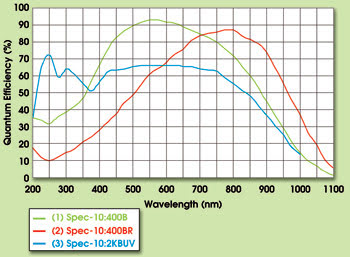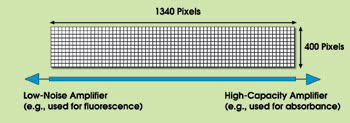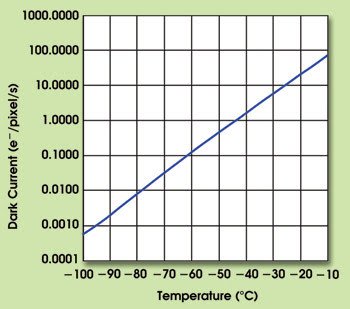Spectroscopy applications also benefit from the latest advances.
Ravi Guntupalli and Jeff Grant, Princeton Instruments
Since their first appearance some 30 years ago, CCDs have been embraced by the scientific imaging and spectroscopy communities for their extraordinary ability to quantify light. Over the years, their performance has been bolstered by a number of breakthrough technologies, including back illumination, for the highest quantum efficiency; deep depletion for near-IR sensitivity; and on-chip multiplication gain for single-photon sensitivity at high speeds.
Whether the application is low-light-level Raman spectroscopy, chemiluminescence imaging, fluorescence or high-light-level absorbance, a scientific camera often must address a rather broad set of requirements simultaneously. A typical list of criteria for CCD-based systems includes high sensitivity from the UV to the near-IR, high speed, wide dynamic range, low dark current, linearity and easy-to-use interfacing to computers and other equipment in the experiment setup.
Performance criteria
Sensitivity. In large part, sensitivity is determined by the quantum efficiency (or the fraction of incident photons absorbed) of the CCD as well as by the system read noise. Back-illuminated CCDs offer quantum efficiency of greater than 90 percent in the visible region, whereas deep-depletion technology extends sensitivity into the near-IR (Figure 1). Special UV processing, meanwhile, enhances the UV sensitivity, which is critical to applications such as semiconductor wafer inspection.

Figure 1. Typical quantum efficiency can vary among detector architectures, as shown for (1) a back-illuminated CCD, (2) a back-illuminated CCD with deep-depletion technology and (3) a back-illuminated CCD with enhanced UV sensitivity.
The read noise of the CCD originates from its onboard preamplifier and is directly proportional to the amount of signal the device is designed to handle (full-well capacity) and the readout speed. State-of-the-art camera systems use ultralow-noise electronics and are limited only by the CCD read noise. By reading out slowly — e.g., at 50 kHz, or 50,000 pixels per second — advanced detection systems such as Princeton Instruments’ Spec-10, routinely achieve read noise of 2.5 e2 rms.
Speed. Although they have many strengths, traditional slow-scan CCDs face a fundamental challenge when it comes to delivering the combination of “greater than video” frame rates and the extremely low read noise needed for applications such as single-molecule fluorescence in the life sciences and adaptive optics in astronomy.
Fortunately, on-chip multiplication gain now satisfies both of these requirements by multiplying the charge right on the CCD — before it reaches the preamplifier. Camera systems that use this technology can be designed to offer software-selectable traditional operation as well, to provide a two-in-one imaging solution.
Dynamic range. This describes the ability of a detector to capture both dim and bright signals. It is specified by full-well/read noise (a ratio of 65,535:1 equals 16 bits). This parameter is particularly important when a small change in signal is measured over a bright background, as in absorbance applications.
In such cases, a single preamplifier may not be able to handle the entire signal from a high-light-level scene because of the constraints that are imposed by read noise and full well capacity. To address this issue, some CCD camera systems can be equipped with dual preamplifiers, one optimized for low-light-level applications and another for wide-dynamic-range applications (Figure 2). Such a design makes it possible to achieve greater than 16-bit performance at all light levels.

Figure 2. When implemented properly, CCDs with dual preamplifiers allow the same camera to be used for low-light-level and wide-dynamic-range applications.
Dark current. Though not a concern for fast-frame-rate applications, dark current — the thermally generated charge in the pixels of a CCD — can be a significant noise source, especially in experiments requiring long exposure times (seconds to hours) or in those in which binning is used, such as spectroscopy applications. Dark current is approximately halved with every additional 5 to 7 °C of cooling (Figure 3).

Figure 3. Newly developed methods of thermoelectric cooling also do not require liquid assistance to achieve dark current as low as 0.0004 e– per pixel per second at 2100 °C, as with the Spec-10 XTE.
Several thermoelectric and cryogenic cooling methods are used to reduce dark current. Until very recently, it had been necessary to use either some type of cryogen (e.g., liquid nitrogen) or external chilled-water circulation for deep cooling. However, a new class of high-performance CCD camera systems implements Princeton Instruments’ advanced XTE thermoelectric cooling and vacuum technologies to achieve 2100 °C without any liquid assistance. Compressor- or liquid-nitrogen-based cooling methods are still needed to reach deeper temperatures.
<linearity.>Linearity. This relates the total output signal (counts) to the total number of incident photons over the full-well capacity of a CCD. This lesser-known performance parameter is critical for quantitative measurement, where the CCD is used as a photometric or radiometric instrument. We measure and provide the linearity of each camera as part of a final test report.
Interfacing. Simply having a high-performance detector is not sufficient anymore. To be truly useful, a camera system also must interface smoothly with other equipment, such as lasers, stages, filter wheels and the like, as well as with advancing computer technology. Consider features such as a USB-2.0 data interface and programmable input/output TTL signals that enable direct control of all aspects of an experiment, which may be indispensable in many imaging applications. Advanced CCD readout modes such as fast kinetics and time-delayed integration now play a key role in many complex experiments.
Looking ahead
Although CMOS detectors hold promise, they will not supplant their CCD cousins in the foreseeable future. CCD detectors and camera systems have evolved over more than three decades, successfully addressing set after set of emergent requirements for scientific imaging and spectroscopy. Propelled by innovative technologies that continue to narrow the gap between detector speed and sensitivity, along with a rapidly growing list of highly useful system features, CCD cameras will remain at the forefront of scientific investigation.
Meet the authors
Ravi Guntupalli is an applications scientist and Jeff Grant a senior writer at Princeton Instruments, a division of Roper Scientific Inc. in Trenton, N.J.; e-mail: [email protected].</linearity.>